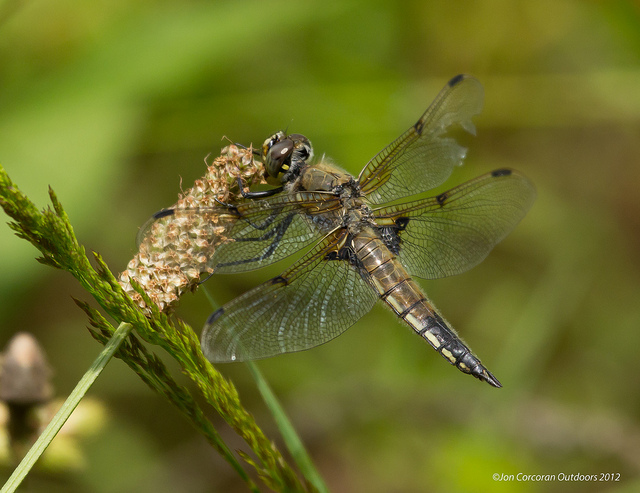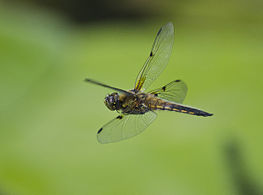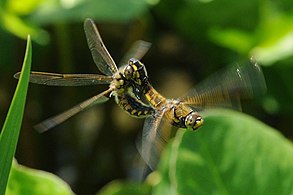Map Snapshot

0 Records
Status
Four-spotted Skimmer (Libellula quadrimaculata) is a northern species of skimmer, found across northern North America, and also ranging across Eurasia. This species is included on the Maryland list based on one historic record (county apparently unknown), and probably a transient individual (Richard Orr's The Dragonflies and Damselflies of Maryland and the District of Columbia).
Seasonality Snapshot
No Records
Source: Wikipedia
| Four-spotted chaser | |
|---|---|

| |
| Male Farmoor Reservoir, Oxfordshire | |

| |
| Female, Kampinos Forest, Poland | |
| Scientific classification | |
| Domain: | Eukaryota |
| Kingdom: | Animalia |
| Phylum: | Arthropoda |
| Class: | Insecta |
| Order: | Odonata |
| Infraorder: | Anisoptera |
| Family: | Libellulidae |
| Genus: | Libellula |
| Species: | L. quadrimaculata
|
| Binomial name | |
| Libellula quadrimaculata | |
Libellula quadrimaculata, known in Europe as the four-spotted chaser and in North America as the four-spotted skimmer, is a dragonfly of the family Libellulidae found widely throughout Europe, Asia, and North America.
The adult stage is found between April and early September in the United Kingdom, and from mid-May to mid-August in Ireland. Larvae have a two-year developmental cycle. Adults feed predominantly on mosquitoes, gnats, and midges;[1] the larvae feed primarily on other aquatic insect larvae and on tadpoles.
There is a variant form, praenubila Newman, which has exaggerated wing spots. This is believed to be related to water temperatures during larval development, and appears to be more common in Europe than in the Americas.
The four-spotted skimmer is the state insect of Alaska.[2]
Habitat
[edit]This active dragonfly mainly lives by ponds, vernal pools, and slow flowing rivers; they are most common in June and July.
Identification
[edit]The brown colour and the four spots on the wings makes them very distinguishable but still could be confused with other Chaser Dragonflies.
Behaviour
[edit]
The male is considered to be highly aggressive and will defend a given territory from incursions from other males of the species. The male is known to form preferences for prominent perches and will often return to the same perches around the margins of pools and ponds whilst it patrols for intruders. Males have a favourable view of the sky during perching. They look toward a section of the sky away from the sun, with less radiation but a higher UV and blue-violet saturation. Thus, the fovea of the eyes, which is sensitive to blue and UV radiation, is optimally suited to the detection of flying insects against the blue sky.[3] Both sexes are prolific fliers, and mating takes place in the air, rather than on perches or amongst the vegetation. The female lays her eggs on floating vegetation. They tend to be easier to approach than Broad-bodied Chasers.
Predators
[edit]The larger emperor dragonfly (Anax imperator) is a predator of this species.[4] Another is the green tiger beetle (Cicindela campestris).[5]
Gallery
[edit]-
female
-
female, variant praenubila
-
In flight
-
Copulation
-
Hunting and returning to a favoured perch at a pond
References
[edit]- ^ "Four-Spotted Skimmer". SHG Resources. Archived from the original on 2009-01-07. Retrieved 16 February 2010.
- ^ "FAQ ALASKA - Frequently Asked Questions About Alaska". sled.alaska.edu. 17 January 2006. Archived from the original on 10 February 2010. Retrieved 28 January 2010.
- ^ Sauseng, Manuela; Pabst, Maria-Anna; Kral, Karl (2003). "The dragonfly Libellula quadrimaculata (Odonata: Libellulidae) makes optimal use of the dorsal fovea of the compound eyes during perching" (PDF). European Journal of Entomology. 100 (4) (published 20 November 2003): 475–479. doi:10.14411/eje.2003.071. ISSN 1210-5759.
- ^ "Emperor Dragonfly". Norfolk Dragons. Archived from the original on 27 May 2009. Retrieved 16 February 2010.
- ^ "An Unexpected Predator of the Four Spot Chaser Dragonfly". 23 January 2009. Archived from the original on 17 November 2017. Retrieved 15 February 2010.
- "Libellula quadrimaculata". Integrated Taxonomic Information System. Retrieved 9 February 2006.
External links
[edit]- USA Distribution Data
- Four-spotted chaser British Dragonfly Society
- Fauna Europaea taxonomy and mapping
- Biolib.cz Libellula quadimaculata photos Biolib.cz taxonomical synonyms and photos
- Photo
- Photo of L. q. praenubila
- Libellula quadrimaculata at AzOdes
- Libellula quadrimaculata at funet.fi
- Libellula quadrimaculata profile and photos
![]() Data related to Libellula quadrimaculata at Wikispecies
Data related to Libellula quadrimaculata at Wikispecies





